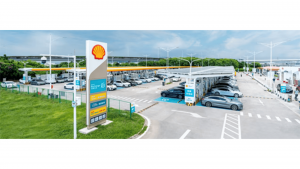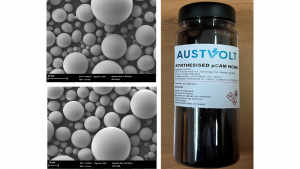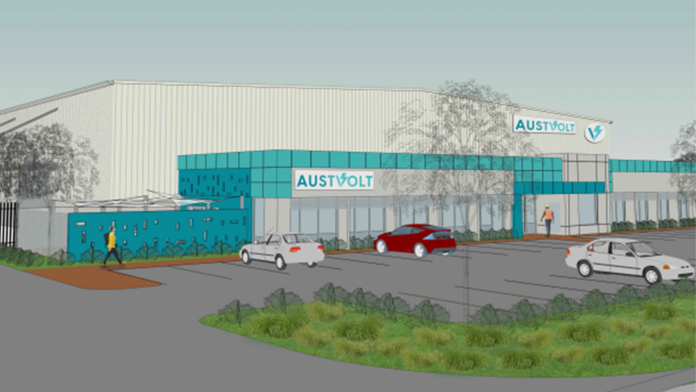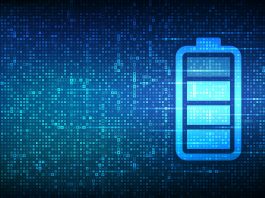Austvolt is poised to become a pivotal player in Australia’s lithium battery industry, driving innovation through advanced pCAM manufacturing.
The transportation industry’s move towards electrification and decarbonisation owes much of its progress to lithium-ion batteries. Precursor Cathode Active Material (pCAM) is a high-value, precisely engineered material which is combined with lithium hydroxide to create Cathode Active Material (CAM). The CAM is then combined with an anode material, typically graphite, and an electrolyte to produce lithium-ion batteries.
The growing electric vehicle market
In 2022, sales of electric vehicles (EV) exceeded 10 million, around 13% of the global vehicle market. This is expected to exceed 30% by 2025. With industry annual growth rates at over 30%, intermediate products such as the pCAM that Austvolt intends to manufacture are experiencing incredible demand, especially from regions such as Europe and North America, where ethical sourcing and transparent carbon traceability are becoming critically important.
EV sales are growing faster than forecasted. Led by Northern Europe and China and driven by government policy, EVs have taken around six years to go from 1% to 10% of new car sales. The following phase is projected to be even faster, as leading nations are anticipated to reach 80% of new car sales within the next six years. By the year 2030, EVs are set to become the predominant choice in the global car market.
The global lithium battery market is poised to expand tenfold from its 2018 size. The swift growth of the market is primarily attributed to the increasing global adoption of electric vehicles. An analysis in 2022 by the McKinsey Battery Insights Team projects that the entire Li-ion battery chain is expected to grow by over 30% annually from 2022 to 2030, when it could reach a value of more than $400bn.
There are a dozen car manufacturers that are dedicated to producing electric cars. In addition, many traditional car manufacturers are also producing electric cars, with many of them planning to transition to electric-only production in the future.
While some in the industry have expressed apprehensions regarding the capacity to meet the charging needs of the burgeoning fleet of electric vehicles, even major players in the oil and gas sector are acknowledging the undeniable shift. As a testament to this recognition, Shell recently inaugurated its most extensive EV charging station in China, featuring 258 public fast-charging points.
Austvolt is strategically placed to become a key participant in this growing market.
What type of lithium battery?
The battery market is currently dominated by two types of lithium batteries – nickel-cobalt-manganese (NCM) and lithium iron phosphate (LFP). The type refers to the type of cathode used in the battery. The NCM batteries have a higher energy density, leading to more driving range, as well as better performance in cold weather and faster charging speeds, but they can be more expensive than LFP batteries.

NCM batteries accounted for over 70% of the electric car market in Europe and 50% of the US market in 2022. This is due to the region’s popularity of long-range electric vehicles and the cold weather performance of electric cars with NCM batteries.
In China, NCM batteries accounted for over 50% of the electric car market in 2022. Other global car markets where NCM batteries are dominant include Japan, South Korea, and Australia.
NCM batteries are expected to remain the dominant battery chemistry in the global car market for the foreseeable future.
The major NCM battery production centres are China, Japan, South Korea and Europe with China accounting for over 70% of global production. Europe is a growing producer of NCM batteries due to the European Union’s ambitious plans to reduce greenhouse gas emissions and promote the adoption of electric vehicles.
Most of the raw materials for NCM batteries come from China, Australia, Indonesia, and the Democratic Republic of the Congo. China is the world’s largest nickel, manganese, and lithium producer.
What is precursor Cathode Active Material?
Li-ion batteries consist of a cathode, an anode, an electrolyte, and a separator. For NCM batteries, the cathode consists of lithium, nickel, cobalt, and manganese. The anode is made from graphite.
The first stage of CAM manufacturing involves chemically combining nickel, cobalt, and manganese into pCAM. pCAM is the key driver of the battery’s performance and contributes to about 30% of the value of the final battery.
pCAM production
pCAM is produced by chemically combining nickel, cobalt, and manganese compounds in various quantities and ratios to meet the customers’ specifications.
pCAM is typically produced using a co-precipitation process. The metal sulphates are mixed in a solution and then precipitated using a chemical agent. The precipitate is then washed and dried to produce the pCAM powder.
Through monitoring the pH, controlling the agitation and process chemistry, the various physical properties of the pCAM, such as size and morphology, can be controlled to ensure that the resulting precursor Cathode Active Material contributes to a battery with long life and high power efficiency.
Byproducts of the pCAM process
The conventional pCAM process produces large quantities of Sodium Sulphate (NaSO4) as a waste product, incurring additional disposal costs.
The Austvolt process uses Potassium Hydroxide (KOH) instead of conventional Sodium Hydroxide (NaOH) as a reagent, resulting in large quantities of potash fertiliser (K2SO4) as a byproduct. This significantly improves the ESG footprint and will provide an additional revenue stream to the business.
What do each of the components do?
Nickel is responsible for energy density and specific capacity, while cobalt and manganese are present for increasing cycle life, structural stability, and safety. Increased nickel content increases energy density and capacity while lowering costs through cobalt replacement.
However, this is at the cost of reduced structural stability and cycle performance. This reduced stability is rectified by doping and/or surface coating of the pCAM.
The pCAM product
pCAM is a powder-like substance. To meet industry specifications, the pCAM product has to have spherical particles, clean surfaces, dense particles with low friability and limited observable fines between particles.

Austvolt’s pCAM product is then shipped to a cathode manufacturer. The pCAM will be lithiated there at high temperature, undergoing a solid-state diffusion reaction to produce the CAM.
Establishing a laboratory facility
Austvolt’s R&D laboratory is located in Bentley Technology Park, Western Australia. In March 2023, Austvolt became the first commercial organisation in Australia to produce high nickel pCAM with NCM 85:5:10 chemistry.
The R&D laboratory is the hub of their continued pCAM synthesis and testing, dedicated to generating samples for prospective off-takers to evaluate. The laboratory began with a two-litre reactor through which pCAM was produced in a series of batches.
The laboratory is currently scaling up to a ten-litre reactor and its associated equipment to allow for a more continuous production process. This new reactor allows for the regular siphoning of synthesised pCAM for testing as new raw materials are added for further experimentation. Within the laboratory there is an array of testing equipment, including a particle size analyser, which enables assessment of the quality of the final product.
The additional equipment will allow for the running of two concurrent production trains, enabling the simultaneous production of pCAM of different chemistries and the production of larger samples for further off-taker testing. The goal is to commission the expanded laboratory by the end of 2023 to prepare for further scaling up to a demonstration-scale plant facility located in Kwinana, Western Australia.
Scaling up to a new tomorrow
Austvolt has secured a nine-hectare site in the Kwinana-Rockingham Strategic Industrial Area, in Western Australia, to establish a demonstration-scale and a full-scale 40,000-tonne per year plant. Through the ongoing support of the Western Australia State and Australian Federal Governments, Austvolt has received invaluable funding to facilitate its production capacity’s growth and expansion.
The construction of the demonstration scale plant is slated for completion in 2025. Environmental impact assessments and surveys are underway, and the company is in talks with several suppliers for equipment and engineering works.
The final phase will involve building and commissioning the full-scale production plant, with a target completion date set for 2027. The anticipated capital cost for the full-scale plant is around AUD$300m. It is poised to generate numerous direct operational and support positions, and provide indirect job growth in the area.
Austvolt’s plant is strategically located
Austvolt enjoys a strategic advantage through sourcing nickel, cobalt, and manganese from Australia’s abundant reserves of critical minerals. Nickel, constituting 80-90% of the pCAM, is mined by BHP and processed at their Kwinana plant, situated in close proximity to Austvolt’s proposed plant. BHP has already provided Austvolt with solid and liquid nickel sulphate quantities to facilitate their ongoing R&D work.
Australia is the world’s third-largest producer of cobalt. It is mined in several locations in Australia, including Western Australia, Queensland and New South Wales. Australia is also the world’s fourth-largest producer of manganese. It is mined in the Northern Territory, Western Australia, and South Australia.
Challenges to establishing high-nickel pCAM manufacturing
The endeavour to establish high-nickel pCAM manufacturing in Australia has several significant challenges. However, the potential for success remains high, driven by the nation’s rich nickel, cobalt, and manganese reserves, advanced engineering capabilities, and strong government backing.
One of the primary obstacles has been sourcing quality raw materials required for production. Strategic partnerships have been forged with local mining companies to tackle this issue. This collaborative approach will ensure a stable supply of raw materials, reduce logistical costs, and minimise the project’s carbon footprint. These initiatives align seamlessly with Australia’s dedication to environmental sustainability.
The integration of state-of-the-art technology presented another formidable challenge. Australia’s accomplished engineers, celebrated for their innovative spirit, undertook the task of tailoring global technologies to suit local conditions. The result is a manufacturing process that exhibits resilience and durability and prioritises energy efficiency. This optimisation will reduce operational costs and position Australia as an eco-conscious, high-nickel pCAM producer.
Australia’s commitment to clean air and waterways has traditionally discouraged high carbon intensity and pollution-producing downstream processing. To address this challenge, Austvolt pursued a novel approach by reimagining the key pCAM manufacturing waste stream of sodium sulphate. Through novel modification of the process, this waste stream has been converted into a valuable fertiliser, potassium sulphate. This enhances the project’s economic viability and contributes to the agricultural sector by offering an Australian-made, environmentally friendly fertiliser.
While the initial investment for this project is substantial, the Australian and State governments, in conjunction with private stakeholders, have recognised the long-term benefits. They have provided essential financial support and incentives, viewing this as a strategic investment into Australia’s future. This support has expedited research and development, ensuring that the high-nickel pCAM manufacturing process remains sustainable and economically viable.
With abundant reserves of essential materials, a rapidly expanding market, technical expertise in designing highly automated production facilities and ongoing collaborative efforts between industry, government, and research institutions, Australia is poised to emerge as significant producer in the pCAM industry.
Austvolt’s vision for the future
At the heart of Austvolt’s mission lies the ambition to position itself as a pivotal player in the global integrated Li-ion battery supply chain. This endeavour is not only a crucial step in contributing to the worldwide shift from fossil fuels to renewable energy sources but also aligns with Australia’s growing manufacturing aspirations.
Peeyush Mathur, Austvolt’s Founder and Managing Director, articulates that the company’s long-term vision is to provide pCAM to a diverse clientele within the battery industry while continually advancing the material’s production processes through continuous research and development. This commitment will ensure a minimal carbon footprint, firmly anchoring Austvolt as a sustainable producer.
Austvolt’s commitment extends to ethical sourcing and traceability, guaranteeing the transparency and integrity of all input materials and underpinning its role as a responsible steward in the global energy transition.
Please note, this article will also appear in the sixteenth edition of our quarterly publication.









